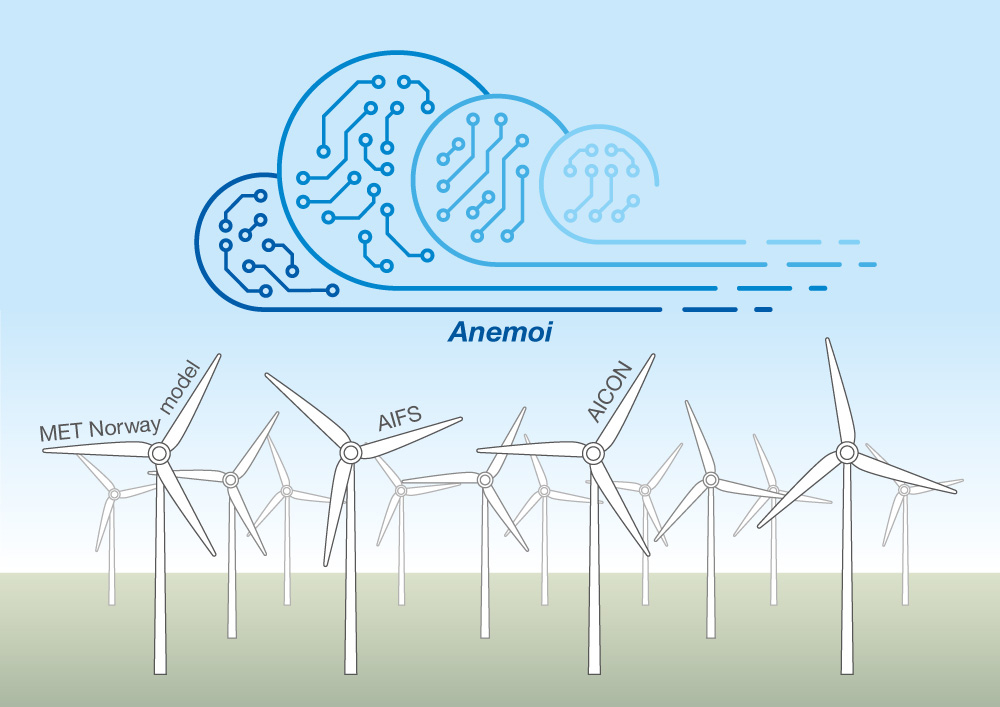A range of national meteorological services across Europe and ECMWF are pleased to announce the launch of Anemoi, a Python-based framework for creating machine learning (ML) weather forecasting systems. Named after the Greek gods of the winds, Anemoi is a collaborative, open-source initiative involving the Spanish State Meteorological Agency (AEMET), the Danish Meteorological Institute (DMI), the German National Meteorological Service (DWD), the Finnish Meteorological Institute (FMI), the Italian Air Force Meteorological Service (ITAF Met Service), the Royal Netherlands Meteorological Institute (KNMI), MET Norway, Météo-France, MeteoSwiss, Belgium’s Royal Meteorological Institute (RMI) and ECMWF. It has the potential to democratise access to and further develop data-driven weather forecasts.
The goal of Anemoi is to provide the key building blocks to train state‑of-the‑art data-driven models and run them in an operational context. As a framework it seeks to handle many of the complexities that meteorological organisations will share, allowing them to easily train models from existing recipes but with their own data.
Components
Anemoi comprises an ecosystem of Python packages, which cover the full life cycle of data-driven modelling. These Python packages each address a crucial aspect of the artificial intelligence (AI) weather forecasting pipeline:
- Anemoi Datasets: This component generates ML‑optimised datasets from various sources and data formats of meteorological data and observations, complete with rich metadata. For example, an optimised subset of ECMWF's ERA5 reanalysis or of a historical operational analysis dataset. It streamlines the often cumbersome process of data preparation, ensuring that high-quality, consistent, and optimised data is available for model training. (https://anemoi-datasets.readthedocs.io)
- Anemoi Training: Understanding that flexibility is key in ML model development, this module allows users to modify most parts of the training through configuration files, without needing to alter the underlying code. This approach democratises access, enabling meteorologists without deep coding expertise to experiment with advanced data-driven weather prediction models. (https://anemoi-training.readthedocs.io)
- Anemoi Models: This package houses the model code, designed with efficiency and minimal dependencies in mind. It ensures that the transition from development to deployment is as smooth as possible. (https://anemoi-models.readthedocs.io)
- Anemoi Inference: Building on ECMWF's experience with the AI Models tool, which has been running daily experimental ML forecasts for over a year, Anemoi Inference enables fast operational deployment of trained models. This component is crucial for integrating ML forecasts into time-sensitive operational workflows. (https://anemoi-inference.readthedocs.io)
- Anemoi Graphs: Supporting custom graph generation, this module is particularly exciting for researchers exploring novel graph architectures. It already supports multi-scale GraphCast-like graphs and stretched-grid graphs showcased recently by MET Norway, with more innovations on the horizon. Graphs can be easily visualised to understand the connectivity. (https://anemoi-graphs.readthedocs.io)
Additional utility tools exist in supporting repositories beyond these core modules. Anemoi builds on top of ECMWF’s Artificial Intelligence Forecasting System (AIFS), expanding that codebase to enable wider functionality for a greater range of users. Future AIFS models will be trained using Anemoi.

Current contributors to Anemoi
A large number of people across the organisations mentioned in this article have already contributed to the Anemoi codebase, and we’d like to thank them by naming them here:
Ana Prieto Nemesio, Baudouin Raoult, Cathal O’Brien, Christian Lessig, Ewan Pinnington, Florian Pinault, Gabriel Moldovan, Gareth Jones, Gert Mertes, Harrison Cook, Helen Theissen, Håvard Homleid Haugen, Jakob Schlör, Jan Polster, Jesper Dramsch, Kasper Hintz, Leif Denby, Magnus Sikora Ingstad, Marek Jacob, Mariana Clare, Mario Santa Cruz, Matthew Chantry, Meghan Plumridge, Michiel Van Ginderachter, Mihai Alexe, Ophelia Miralles, Rilwan Adewoyin, Sándor Kertész, Sara Hahner, Simon Lang, Simon Kamuk Christiansen, Steffen Tietsche.
Collaborative and data-driven innovation
Anemoi represents a significant European effort to pool expertise and resources, at a time of rapid changes in weather forecasting. It is not just a technical framework but a philosophy of open collaboration, which we believe is essential for tackling the complex challenges of modern meteorology. The code is freely available on github, under a permissive licence, meaning that anyone can contribute to its development or use it for their activities.
AEMET, DMI, DWD, FMI, ITAF Met, KNMI, MET Norway, Météo-France, MeteoSwiss, RMI and ECMWF have joined together to further develop this code, with some using it as a basis for their data-driven activities. It supports collaboration across borders, leveraging the best tools and knowledge to develop new forecasting methodologies. This cooperative approach ensures that Anemoi can adapt to evolving scientific and technological advancements and will facilitate the integration of ML algorithms into existing forecasting workflows. Anemoi offers a platform for experimentation and development, encouraging stakeholders to test novel techniques and share results.
We look forward to more contributions from the organisations currently contributing to Anemoi as well as others, as we together develop a tool by the community and for the community.
The vision of Anemoi
The development of Anemoi aligns with ECMWF’s commitment to improving forecast accuracy and reliability in the face of changing climate conditions. By utilising ML weather models, Anemoi aims to significantly improve short-term and long-term forecasts, helping societies better prepare for extreme weather events.
Looking ahead, the project plans to expand its network of collaborators, welcoming new partners to contribute to this innovative initiative. This expansion will not only increase the diversity of input data but also drive further advancements in ML applications for meteorology, including new AI real-time services to support national meteorological services.
We invite the global meteorological community to join us in this exciting journey. Whether you are a seasoned ML practitioner, a meteorologist curious about new technologies, or a student looking to shape the future of weather forecasting, there might be a place for you in the Anemoi community.
To stay updated on Anemoi contributions from ECMWF, visit the AIFS blog: https://www.ecmwf.int/en/about/media-centre/aifs-blog.
